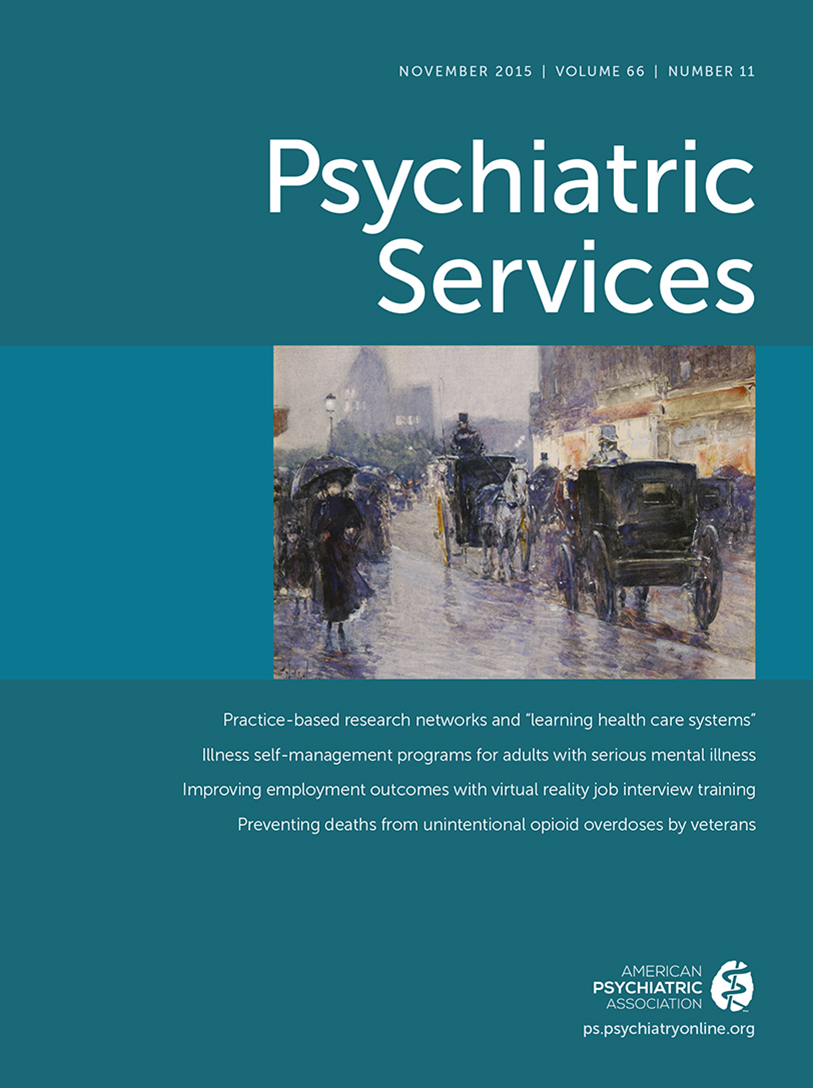This Month’s Highlights
PBRNs Address Research-to-Practice Gap
The average research-to-practice gap in health care is 17 years. One way to close the gap is through practice-based research networks (PBRNs), which are collaborations between academic researchers and groups of health care providers. PBRNs identify questions whose answers would improve clinicians’ effectiveness. Clinicians then collaborate with researchers in developing a study, collecting and analyzing data, and implementing findings. In 2012, the nation’s first PBRN to focus on individuals with serious mental illness—the Recovery-Oriented Care Collaborative (ROCC)—was established in Los Angeles. In this month’s Research & Services Partnerships column, Erin L. Kelly, Ph.D., and colleagues describe ROCC’s four-phase development, focusing on key replicable components. The question selected for ROCC’s initial study was “What is the impact of integrated health care services on emergency room and primary care usage, physical health, mental health, lifestyle, and overall satisfaction with services?” (page Original article: 1132). In a related letter to the editor, these authors report results of a survey of Los Angeles consumers conducted in phase 3 of ROCC’s development (page Original article: 1253). In a Taking Issue commentary, Gregory E. Simon, M.D., M.P.H., notes that PBRNs can lead to the establishment of continuous measurement as a core function of health care. Continuous inquiry and continuous measurement, in turn, can result in “a learning health care system”— an ongoing collaboration between patients, clinicians, health system leaders, and researchers (page Original article: 1129).
Pediatric Screening and Colocated Services
In 2003, the pediatric clinics of the Cambridge Health Alliance, a Massachusetts public health system, began to phase in behavioral health screening at all well-child visits and brought in social workers to provide on-site services. The assumption was that earlier identification and treatment would increase use of ambulatory behavioral health care and reduce inappropriate emergency department and inpatient admissions. When Karen A. Hacker, M.D., M.P.H., and colleagues analyzed 2003–2008 data for 11,223 children, they found that more children received ambulatory behavioral health treatment. However, an unexpected finding was that child behavioral visits to the emergency department doubled. The authors discuss possible reasons for this finding (page Original article: 1141).
Reducing Deaths From Unintentional Overdoses
Prescription opioid medications are the most commonly implicated substances in deaths from unintentional overdoses. To help inform interventions to prevent such overdoses, Lewei (Allison) Lin, M.D., and colleagues examined data for all Veterans Health Administration (VHA ) patients who died in 2004–2007 from unintentional opioid overdoses and who used VHA services anytime within two years of their deaths (N=1,813). Most of the patients were seen in outpatient settings within a month of their overdose, and these settings may provide an important opportunity for intervention (page Original article: 1149).
A Guide to Illness Self-Management Programs
Illness self-management (ISM) programs for adults with serious mental illness offer strategies to promote recovery, maximize wellness, and increase independence. Given the range of programs, the personal nature of recovery, and variations in agency cultures, priorities, and resources, how can consumers and providers choose an intervention that best meets their needs? Ryan Petros, M.S.W., L.I.C.S.W., and Phyllis Solomon, Ph.D., describe, review evidence for, and provide guidance to inform decisions about five of the most popular ISM programs: Pathways to Recovery, The Recovery Workbook, Building Recovery of Individual Dreams and Goals through Education and Support, Wellness and Recovery Action Planning, and Illness Management and Recovery. Evidence of effectiveness was found to range from low to moderate. However, the authors’ focus on contextual domains may offer the most relevant guidance for program selection (page Original article: 1180).
Virtual Reality Training Leads to Job Offers
Individuals with severe mental illness have low employment rates, and the job interview presents a critical barrier to competitive employment. Matthew J. Smith, Ph.D., M.S.W., and colleagues assessed employment outcomes among 39 adults who participated in virtual reality job interview training. An innovative interactive software application allowed trainees to master interview skills at three difficulty levels. During each virtual interview, a character named Molly Porter, a human resources manager at a large department store, asks questions about skills and experiences. Molly selects questions from 1,200 customizable options. The authors found that individuals who completed the training were significantly more likely than a comparison group to receive a job offer in the six months after training (page Original article: 1173).
Briefly Noted
| • | A brief, three-month focus on coordination of services after psychiatric hospital discharge helped patients avoid being caught in the “revolving door” of frequent rehospitalization (page Original article: 1155). | ||||
| • | The Integrated Care column describes essential elements of a patient-centered health care home model in Pennsylvania developed to improve outcomes for individuals with autism spectrum disorder or intellectual disability (page Original article: 1135). | ||||



